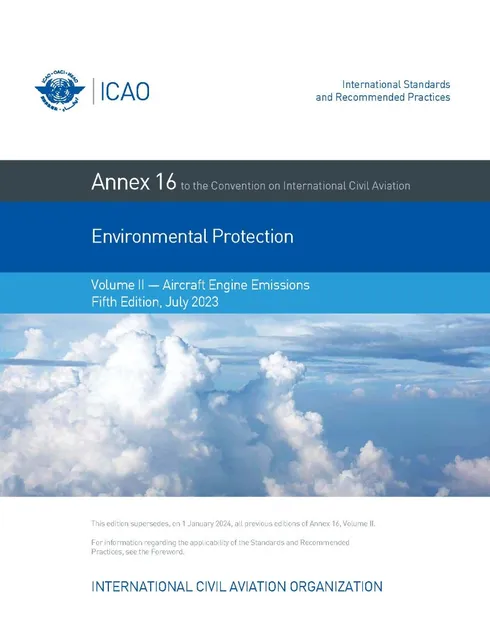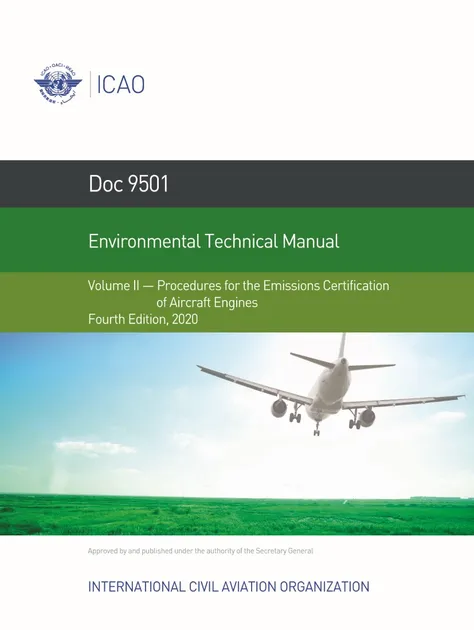To address the effects of aviation emissions on the environment, this year ICAO updated Annex 16, which covers environmental protection. Early in 2023, ICAO adopted new and updated standards and amendments to further address environmental factors. There are four volumes of this Annex to the Chicago Convention: Volume I covers aircraft noise; Volume II covers aircraft engine emissions; Volume III covers aeroplane CO2 emissions and Volume IV is the edition that covers the Carbon Offsetting and Reduction Scheme for International Aviation (CORSIA).
Annex 16, Volume II contains Standards for aircraft engine emissions and is accompanied by related guidance material and technical documentation. Since the late 1970s, we have been working on ways to reduce the adverse effects of airplane engine emissions.  The main goal of Volume II is to decrease the negative environmental consequences linked to airplane engine emissions, particularly regarding air quality and climate change. This updated edition offers clear and more consistent guidelines, creating a more detailed framework for certifying and operating airplane engines according to specific emissions standards.
The main goal of Volume II is to decrease the negative environmental consequences linked to airplane engine emissions, particularly regarding air quality and climate change. This updated edition offers clear and more consistent guidelines, creating a more detailed framework for certifying and operating airplane engines according to specific emissions standards.
This revised Annex 16, Volume II is organized into four sections, each dealing with different aspects of airplane engine emissions. Part I scopes key terms and definitions. Part II sets out Standards related to vented fuel, aiming to prevent intentional fuel venting. Part III contains pollutant emissions Standards and certification procedures for various types of aircraft engines used in international civil aviation. Lastly, Part IV introduces Recommended Practices for assessing non-volatile particulate matter for inventory and modelling purposes.
The new edition of Annex 16, Volume II doesn’t create stricter standards, instead, it refines the existing framework by making it clearer and more consistent. These new guidelines took effect on 31 July 2023, with a practical use date of 1 January 2024 to give stakeholders enough time to adjust their processes and procedures accordingly.
Civil aviation authorities (CAAs) and airplane and engine manufacturers are the main beneficiaries of these provisions. CAAs can use the Standards and Recommended Practices to create, update, and oversee national certification processes and procedures for aircraft engine emissions. This brings consistency among national regulations and strengthens international efforts to reduce the environmental impact of aviation.
Aeroplane and engine manufacturers can use Annex 16, Volume II to ensure their designs and manufacturing comply with the standards. By following the established processes and rules, they can play a significant role in reducing the aviation industry’s emissions.
Service providers for airplane manufacturers and CAAs can also benefit from these updates because they are vital to maintaining engine certification tests. By following the new certification procedures and standards, these stakeholders ensure the reliability of engine emissions testing. This, in turn, contributes to accurate assessments of emissions and adherence.
As the global aviation industry continues to grow, it is crucial to limit the impact of airplane aircraft engine emissions on the environment. With the release of the revised Annex 16, Volume II, ICAO is taking a significant step towards addressing this vital issue.
ICAO released updates to four volumes of Annex 16:
- Volume I – Aircraft Noise: 68-page amendment
- Volume II – Aircraft Engine Emissions: new 5th edition, 176 pages
- Volume III – Aeroplane CO2 Emissions: 14-page amendment
- Volume IV – Carbon Offsetting and Reduction Scheme for International Aviation (CORSIA): new 2nd edition, 124 pages
Annex 16 is available on ICAO’s eLibrary platform. The eLibrary provides users free access to read-only versions of publications with tools for citation, sharing, bookmarks, highlighting text, and inserting comments. Users can reference important information, return to their bookmarked documents and color code their comments to find content in several publications easily. We notify subscribers when publication updates become available and provide access to additional services (like downloading and printing) for those who have subscribed. Sign up to get your access here.


